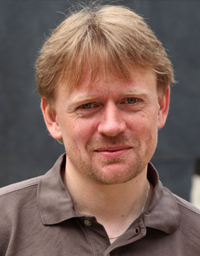Johan Fynbo receives €1M from EU-fund
Astrophysicist Johan Fynbo, Dark Cosmology Centre at the Niels Bohr Institute has been awarded 1 million Euro from the European Research Council, ERC, to research galaxies in the early universe. The funding body supports talented young researchers with project proposals for groundbreaking and cutting edge research.

Astrophysicist Johan Fynbo, Dark Cosmology Centre at the Niels Bohr Institute has been awarded €1 million from the European Research Council, ERC, to research galaxies in the early universe.
"The foundation grant is a great recognition and offers new opportunities for strengthening the research. In addition to strengthening the research, the prestigious grant from ERC will also indirectly increase the opportunities to get access to the observatories and space telescopes and thereby paving the way for groundbreaking discoveries”, explains Johan Fynbo.
The aim of Johan Fynbo’s research project is to understand the first galaxies formed in the early universe after the Big Bang – from the first small accumulations that slowly collapsed due to gravity and formed bigger structures. This process relies heavily on a dominant, yet unknown form of matter – dark matter. He will not use just one method to study the galaxies, but three different methods.
Complete picture of the galaxies
"With one method you can only study a little corner and get a narrow view of the galaxies, which are large, complex structures in the universe. That is why I will study them using three different methods and get a more complete picture”, explains Johan Fynbo.
One method is studying gamma-ray bursts, which are bursts from exploding giant stars. By studying gamma-ray bursts you learn about the gases in the galaxy. Depending on how much gas the galaxy contains and whether it is mostly the lighter elements or whether there is a higher content of heavier elements, you can determine the evolutionary stage of the galaxy and how active it is in star formation. He will use the new X-shooter spectrograph on the giant European telescopes, VLT in Chile, to study the gamma-ray bursts.
He will also use the X-shooter to look for light sources such as active galactic quasars that shine through the galaxy in front of them. This could help determine the size of the galaxy and gain knowledge about its outer parts.
Using ESO's infrared survey-telescope, VISTA, you can create an ultra-deep image of a section of the sky and here he will search for galaxies that are from around 500 million years after the Big Bang (the Big Bang took place 13.7 billion years ago). It is in this period that they believe the first galaxies were created.
The €1 million awarded will be given over five years, during which Johan Fynbo will establish his own research group. He already has 4 PhD students working with him and will now be able to create two more postdoc positions.
